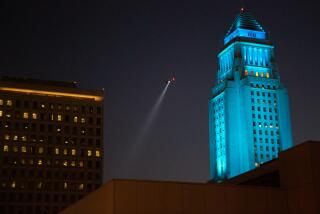The FAA Can and Should Control Helicopter Noise
- Share via
The Times editorial on helicopter noise lets the Federal Aviation Administration dismiss too easily its own mandate to regulate noise from aircraft.
It is well known that the FAA has a mandate to regulate the aircraft industry to ensure the safety of the operators and the passengers. But the FAA has been reluctant to acknowledge that it also has an express statutory duty to regulate for the control of aircraft noise.
The FAA’s enabling legislation (49 U.S.C.1431) specifically provides it full authority, if it has the willpower to use it, to address noise along with safety.
The FAA is indeed now involved, under that very mandate, in pending interagency efforts to address noise and other environmental issues concerning sightseeing overflights in national parks.
The time has passed when the FAA (or any other public agency) can ignore its charge to attend to pressing environmental needs of the public it serves and impacts.
If the FAA is doing a commendable job of “traffic control in crowded skies,” as The Times asserts, then let it with equal alacrity perform its corresponding role: help curb the environmental impact on noise-sensitive areas below.
Raising the minimum level of helicopter flights seems an obvious way, since they are the most annoying and low-flying aircraft. There may need to be other regulations from the FAA.
Nor are the helicopter overflights a problem only affecting the San Fernando Valley. They impact on the residential areas on Cahuenga Pass/Hollywood terribly, and cause problems in many areas of the Los Angeles Basin.
It is the FAA, not the local political leadership, which has failed to assert the FAA’s mandate to start doing something about ensuring reasonable quietude for those who must live beneath all those helicopters.
There’s no time like right now to start.
DICK HINGSON
Los Angeles
* I am astounded that the Los Angeles Times would criticize elected officials for writing letters in support of their constituents who are tired of helicopter noise (“Real Buzz on Helicopter Noise,” Nov. 28). Our politicians’ support of the 1,000-foot minimum altitude requirement is fully justified on both legal and factual grounds.
Your editorial incorrectly challenges the legal basis of the politicians’ support by claiming that the FAA cannot adopt regulations to control and abate aircraft noise. Your criticism is unfounded because the FAA does have this power and has used it to address noise problems in the northeast and other areas.
As to the factual basis for supporting the minimum altitude requirement, the severity of the noise problem is evidenced by the overwhelming public outcry over helicopter noise and support for the 1,000-foot minimum altitude requirement. Your safety concerns with the proposed requirement are unsubstantiated and, if present, could be addressed in the final regulations. Most of the low-flying helicopter traffic creating the noise problem is not near airports, but rather over residential areas where no fixed-wing aircraft should be traveling at that altitude.
While acknowledging that noise abatement is a reasonable goal, the Los Angeles Times criticizes the minimum altitude requirement without suggesting another alternative. Does the Los Angeles Times support restricting early morning hours of operation at Van Nuys Airport, an alternative clearly within the power of the Los Angeles City Council and the owner of the airport? Does the Los Angeles Times support the mandatory pooling of traffic and other media helicopters by the television and radio stations?
I only wish the Los Angeles Times could be as constructive as the politicians it criticizes.
HOWARD M. HEITNER
Los Angeles
More to Read
Inside the business of entertainment
The Wide Shot brings you news, analysis and insights on everything from streaming wars to production — and what it all means for the future.
You may occasionally receive promotional content from the Los Angeles Times.










